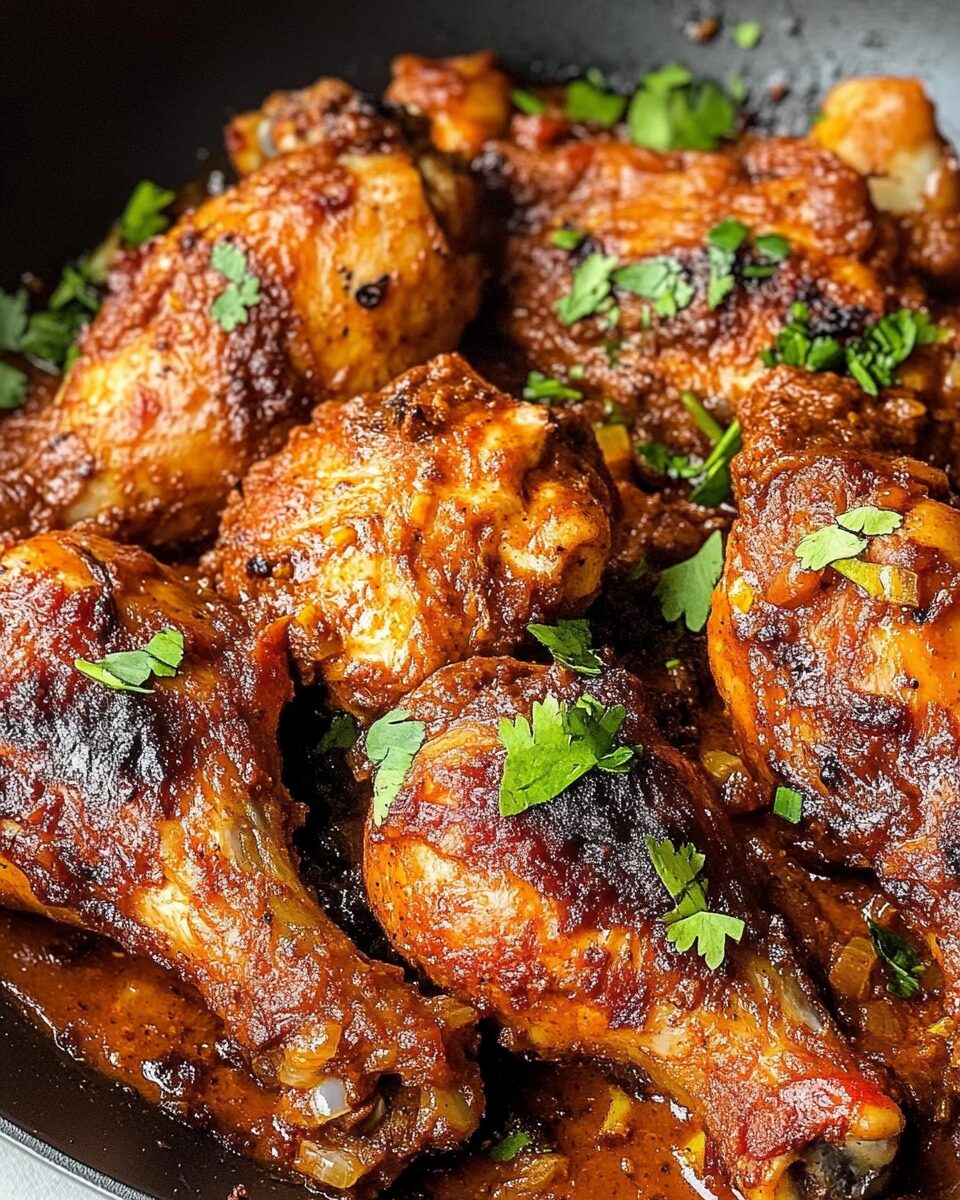The heart of Congolese cuisine beats in the warm, rich depths of Moambe Chicken. This iconic dish, also known as Poulet Moambe, combines savory chicken with a deeply flavorful sauce made from creamy peanut butter and palm oil. Balanced with spices like smoked paprika, garlic, and ginger, this dish is soul-satisfying and deeply rooted in tradition. Whether you’re exploring African flavors for the first time or bringing a taste of home to your table, Moambe Chicken is sure to impress. This low-carb version keeps all the authentic taste without sacrificing your health goals. Pair it with cauliflower rice or a simple vegetable side for a complete, nourishing meal that’s both exotic and comforting.
Full Recipe:
Ingredients:
-
2 pounds chicken (drumsticks or thighs preferred)
-
1 onion, chopped
-
4 garlic cloves, minced
-
1 teaspoon ginger, minced
-
1 tablespoon smoked paprika
-
1 teaspoon cayenne pepper (optional)
-
2 tablespoons tomato paste
-
1 cup chicken broth
-
1 cup natural peanut butter (unsweetened)
-
1 cup palm oil or red palm butter
-
Salt and pepper to taste
-
2 tablespoons olive oil
-
1 bay leaf
Directions:
-
Heat olive oil in a large skillet over medium heat. Brown the chicken pieces on all sides and set aside.
-
In the same skillet, add chopped onion and sauté for 2–3 minutes until translucent.
-
Add garlic and ginger and cook for another minute. Stir in tomato paste, smoked paprika, cayenne pepper, salt, and pepper.
-
Pour in chicken broth and mix well. Return chicken to the skillet and add the bay leaf.
-
Simmer covered on low heat for 25–30 minutes, stirring occasionally.
-
In a separate saucepan, gently melt the peanut butter with palm oil over low heat until smooth.
-
Pour the peanut-palm mixture over the chicken and simmer uncovered for another 15 minutes until the sauce thickens and coats the chicken.
-
Serve hot with cauliflower rice or steamed vegetables for a low-carb option.
Prep Time: 15 minutes | Cooking Time: 45 minutes | Total Time: 1 hour
Kcal: 430 kcal | Servings: 6 servings
Discover the Rich Heritage of Moambe Chicken: Congo’s Beloved National Dish
Moambe Chicken, or Poulet Moambe, is much more than just a savory stew it’s a symbol of Congolese identity, heritage, and culinary pride. Known across Central Africa and particularly prominent in the Democratic Republic of Congo and Republic of Congo, this hearty chicken dish stands as a testament to the powerful combination of culture, tradition, and comfort food. It’s often considered the national dish of the DRC, enjoyed during family gatherings, holidays, and ceremonial occasions.
This article delves into the origins, cultural significance, flavor profile, nutritional aspects, and serving ideas for Moambe Chicken. Whether you’re a foodie interested in global cuisine or someone searching for a flavorful low-carb meal with deep cultural roots, Moambe Chicken is a dish that deserves a spot in your kitchen and on your table.
The Origins and Cultural Significance of Moambe Chicken
Moambe Chicken originates from the Congo River region, where culinary traditions reflect the diverse ethnic groups that inhabit this lush, tropical area. The word “moambe” itself refers to a type of palm butter or palm nut sauce a thick, reddish condiment made from cooked and pounded palm nuts. This sauce is the heart of many Central African stews and imparts a distinct taste and texture to everything it touches.
In Congolese households, Moambe Chicken is often prepared during important cultural events or when honoring guests. Its preparation is a form of culinary storytelling, passed down from generation to generation, each family adding their personal twist to the dish. The use of palm oil and peanut butter in Moambe Chicken symbolizes abundance, warmth, and familial love, making it an integral part of celebratory feasts.
In neighboring countries such as Angola, Gabon, and Cameroon, similar versions of the dish exist, often featuring local spices and cooking styles. But it’s in the Congo where the dish truly shines as a cultural icon.
The Unmistakable Flavor Profile of Moambe Chicken
Moambe Chicken is beloved for its unique and deeply comforting flavor. The dish combines the earthy richness of palm oil or palm butter with the nutty creaminess of natural peanut butter, creating a velvety base sauce that coats each piece of chicken beautifully. The addition of tomato paste, garlic, onions, and spices like paprika and cayenne adds complexity and depth to the stew.
This fusion of flavors results in a profile that is simultaneously savory, slightly sweet, spicy, and intensely aromatic. The sauce is thick and clingy perfect for sopping up with traditional sides like fufu, rice, or, for a low-carb twist, cauliflower rice or roasted vegetables.
It’s a flavor unlike any other, often described as “bold but balanced.” For those trying it for the first time, Moambe Chicken offers a sensory journey each bite a warm reminder of Africa’s lush rainforests and vibrant kitchens.
Health Benefits and Nutritional Value
Moambe Chicken can be both indulgent and healthy, especially when adapted for low-carb, gluten-free, or paleo diets. Traditional recipes may use starchy sides and commercial oils, but you can easily modify the dish for a more nutritious profile without sacrificing authenticity.
Protein-Packed
The chicken itself is a great source of lean protein, making this dish satisfying and muscle-friendly. Using skinless chicken thighs or drumsticks adds flavor without excessive fat.
Healthy Fats
Palm oil, while sometimes controversial, is a natural source of antioxidants like vitamin E and beta-carotene. When sustainably sourced, red palm oil adds not only flavor but also essential nutrients. Peanut butter brings in monounsaturated fats that support heart health and provide long-lasting satiety.
Low-Carb Options
By omitting traditional sides like rice or fufu, and instead serving the dish with cauliflower rice or sautéed greens, this recipe becomes a low-carb powerhouse. It’s ideal for those on keto or paleo diets.
Anti-Inflammatory Ingredients
Ginger, garlic, and paprika aren’t just flavor agents they also boast anti-inflammatory and antimicrobial properties that support overall health.
Moambe Chicken in Modern Kitchens
As more people seek to explore international cuisine from their own homes, Moambe Chicken has found a new audience outside of Central Africa. Food bloggers, chefs, and home cooks around the world are discovering the magic of this one-pot wonder.
It’s an excellent dish for meal prepping due to its rich flavor and thick sauce that gets even better after a day or two. The ingredients are widely available peanut butter, chicken, tomato paste while the unique palm oil or palm butter can now be sourced from international grocery stores or online retailers.
Whether you’re new to Congolese food or a longtime fan of African cuisine, Moambe Chicken can easily become a comforting regular in your recipe rotation.
How to Serve Moambe Chicken
Traditionally, Moambe Chicken is served with:
-
Fufu: A starchy dough-like side made from cassava or plantains that helps scoop up the thick sauce.
-
White rice: Perfect for soaking in the flavorful moambe sauce.
-
Saka saka: Cooked cassava leaves often served as a vegetable side dish.
For a low-carb or keto-friendly meal, try serving Moambe Chicken with:
-
Cauliflower rice: Light and fluffy with minimal carbs.
-
Zucchini noodles: A fresh, modern twist.
-
Steamed broccoli or sautéed kale: Great for adding fiber and color to your plate.
To complete the meal, consider a fresh cucumber salad or a tangy lime slaw to balance the richness of the stew.
Advertisement
Embracing Culinary Heritage Through Food
What makes Moambe Chicken so special is how it transcends being “just a dish.” It connects people to a shared African heritage, showcases the richness of indigenous ingredients, and bridges traditional and modern cooking techniques. When you prepare Moambe Chicken, you’re not only nourishing your body you’re honoring centuries of culinary wisdom.
Many African dishes are still underrepresented in global food media. By sharing recipes like Moambe Chicken, we contribute to a broader appreciation and understanding of Africa’s rich and diverse food culture. And in doing so, we keep those stories alive.
Conclusion:
Moambe Chicken is more than a meal it’s an experience. Rich, flavorful, and deeply rooted in culture, it invites you to slow down, savor, and connect. It’s also versatile and adaptable to various dietary lifestyles, proving that traditional dishes can evolve without losing their essence.
Whether you serve it for a family dinner, a cultural celebration, or a weeknight treat, this Congolese classic brings warmth to the table and joy to the palate.

